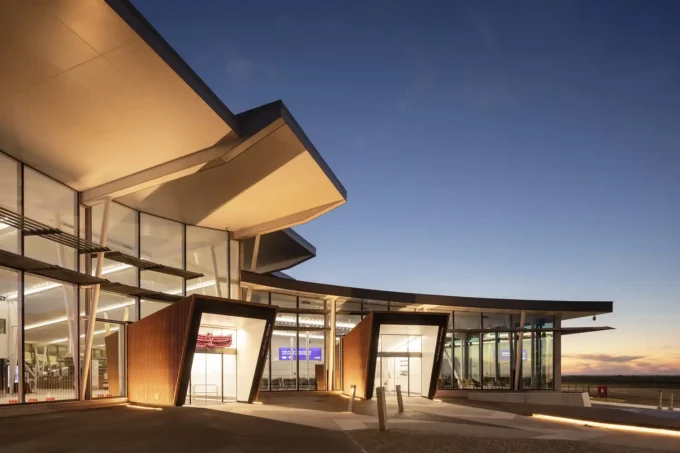Set in the lush foothills of Lishui, a city often referred to as a “forest city” in southeastern China, the new Lishui Airport (LIJ) is rapidly approaching completion and is expected to open its doors by the end of 2024. Designed by the internationally renowned MAD Architects, this regional airport presents a vision that goes beyond functionality, aiming to become a poetic extension of the city’s natural and cultural identity.
Led by Ma Yansong, MAD’s founding principal, the design embraces a unique philosophy—one where architecture is not an imposition upon the land, but a respectful and seamless integration into its terrain.

Shaping a Terraced Landscape
The airport occupies a vast site spanning 2,267 hectares, with the terminal building covering 12,000 square meters. Given the site’s steep terrain, the construction demanded a significant transformation of the landscape—requiring a nearly 100-meter reduction in elevation. This process resulted in a tiered design strategy where the terminal, offices, and parking areas sit on a series of descending terraces.
This terraced layout not only addresses the site’s topographic challenges but also reflects a deeper design ethos: to work with the land rather than against it. The result is an airport that appears to emerge organically from the hillsides, aligning with the broader vision of Lishui as a sustainable, green city.
Architectural Lightness and Structural Innovation
At the heart of the airport is a striking silver-white roof, crafted from lightweight aluminum panels. It floats gently above the terminal like a feather—both in materiality and visual impact. The roof is supported by 14 umbrella-shaped columns, which not only serve a structural purpose but also echo the organic forms found in nature.
A standout architectural feature is the 30-meter cantilever that forms a dramatic entrance canopy. Beneath it, the concourse glows with natural daylight streaming through a central skylight, creating an atmosphere that’s simultaneously calm, welcoming, and deeply connected to the outside world.
In Ma Yansong’s own words:
“Lishui is a garden city, and her airport should also be in a garden. It’s not about grandeur, but about convenience, humanity, and a dialogue with nature.”

A Human-Scaled Experience
Step inside the terminal and visitors are greeted by a warm, wood-toned interior, in sharp yet harmonious contrast to the exterior’s futuristic metal shell. The internal ceiling rises from 4.5 meters to 13 meters, carefully balancing intimacy and openness depending on the function of each space.
The terminal’s “one-and-a-half-story” configuration is a masterstroke in efficient design. It merges arrival and departure functions into a single compact volume, streamlining circulation and reducing spatial redundancy. A double-height central lobby adds a sense of vertical grandeur while maintaining ease of movement.
Connecting Nature and Travel
Another key feature of the design is the landscaped pedestrian walkway leading from the parking areas directly into the terminal. Rather than separating vehicles from foot traffic through conventional barriers, this approach encourages a softer transition between modes of travel, reinforcing the airport’s seamless relationship with its natural surroundings.
Lishui Airport is not merely a hub for transit; it is conceived as a public space that belongs to the city. This human-centric, landscape-driven approach sets a new precedent for regional airport design in China and beyond.
Capacity, Growth, and Future Expansion
Though initially planned as a domestic feeder airport, Lishui Airport is built with future growth in mind. Upon opening, it will feature:
-
3 boarding bridges
-
5 remote stands
-
Annual capacity for 1 million passengers
By 2030, this capacity is expected to rise to 1.8 million passengers, and by 2050, to 5 million. Importantly, the masterplan includes provisions for an international terminal, enabling the facility to scale as the region continues to develop.

Collaboration and Creative Teams
The realization of Lishui Airport has been a complex and highly collaborative endeavor. MAD Architects partnered with a wide array of consultants and experts, including:
-
Executive Architects: CAAC New Era Airport Design Institute
-
Façade Consultant: RFR Shanghai
-
Interior & Lighting: Shanghai Xian Dai Architectural Decoration & Landscape Design Research Institute
-
Landscape Consultant: Z’scape Landscape Planning and Design
Photography credits include JK Wang, Liu Yongwei, and MAD Architects themselves, capturing the poetic essence of this soon-to-be icon.
A New Model for Future Airports
In a world where transportation infrastructure often emphasizes scale and efficiency over experience, Lishui Airport stands apart. It’s a project rooted in humility, designed to enhance convenience, and shaped by a profound sensitivity to the land. Rather than dominating its environment, it responds to it—with elegance, softness, and grace.
As the airport opens later this year, it promises to become more than a transit point. It will be a place of arrival, of departure, and of deep connection—between people, place, and nature.
Photography: MAD Architects
- Airport architecture and nature
- Airport interior wood design
- Airport with natural daylight
- China regional transportation hub
- Eco-friendly airport projects
- Future expansion airport masterplan
- Human-centered airport terminal
- Innovative airport structural design
- Landscape-integrated airport terminal
- Lightweight aluminum roof airport
- Lishui Airport MAD Architects
- Lishui forest city airport
- Ma Yansong architecture
- MAD Architects airport design
- Organic architectural design
- Pedestrian-friendly airport design
- Regional airport China
- Sustainable airport architecture
- Terraced landscape design
- Umbrella-shaped columns design



































Leave a comment